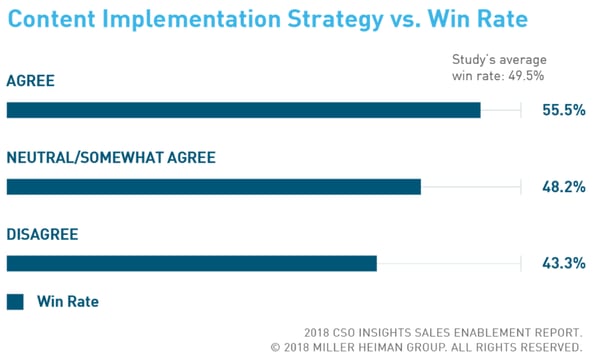
It’s a well-documented fact that content plays such a huge role in sales today. More and more companies are investing in content for their sales strategies, particularly in sales enablement.
Sales enablement is a system that provides sales teams with strategies, processes, tools, technology, and other resources to help them sell more effectively. Everything from your CRM to the training sessions and marketing campaigns are all part of sales enablement—because they "enable" you to sell better. Content is one such sales enablement tool.
Content in the sales enablement context may include blog posts, infographics, podcasts, white papers, e-books, case studies, presentations, social media posts, brochures, web copy—anywhere and everywhere content is needed to convey expertise, credibility, and knowledge and build customer confidence and trust. Sales enablement content also includes content in training manuals or modules, sales playbooks, sales plans, and other internal sales references.
So they can sell more efficiently and effectively, sales reps have been relying on content to truly personalize the customer buying experience. Generic pitches don’t make the cut anymore: all customers are smarter and more discerning these days. So the kind of content AND content strategy sales teams use truly matters. Take note that these two work side by side: You can’t have content and not have strategy. In fact, companies with a clear content strategy experience a 55% win rate as compared to 43% win rate for organizations without one.

(source)
If you want your sales enablement content to achieve the results you want, you have to pay attention to its creation and distribution. The quality of the content matters a lot too.
So how do you create content for sales enablement that will help sell and convert? Here are some best practices for creating sales enablement content.
1. Deliver outstanding value
You have to remember that you are not the only one creating content for potential customers. Everyone has received the memo: Everyone knows that content works. So how do you make sure that you are not just content clutter—you know, the type that just adds to the hundreds and thousands of content out there but is not really being read or remembered? You have to deliver value, and outstanding value at that.
You must offer credible insight, timely solutions, relevant (meaning appropriate to the current time, period, or circumstances) information; groundbreaking and forward-thinking analysis; and fresh ideas. Your strategy should be to plan content that deliver on these goals. Following this strategy not only demonstrates your expertise and knowledge; it helps transform your content into something indispensable.
2. Develop the brand tone and language
What you want to say is important, how you say it is also critical. Brands develop brand personalities all the time. Brand tone and language should help convey that brand personality. How your brand speaks to its customers plays a vital role in developing a relationship with them.
Always aim to be accessible. When trying to assert your expertise, it’s easy to get carried away and forget the audience. But your audience must be your focus. Use the language that customers will easily understand and appreciate. Use a tone that renders your brand approachable.
Consistency is also important. Sales reps, marketers, customer service, etc. must employ this brand tone and use the brand language.

3. Have sales reps help shape the content
It still amazes us how some marketing teams can create content and come up with campaigns without ever getting the input of the sales reps or teams. They are the ones in touch with prospects and so they know their concerns, questions, objections, hesitations, pain points, and motivations to purchase. Sales reps can, in fact, provide the kind of content that needs to be created.
Besides getting sales reps’ input on topics, get their input on formats too. The kind of content they need will vary depending on the situation. If you’ve got a highly technical and/or highly customized product, a Frequently Asked Questions page and/or product video might be in order. If the product is business results-driven, they may need case studies, infographics, and white papers to support the claims.
The best way to strategize on content is to consult with the sales reps on these matters:
• What do they need the content for? (e.g. For qualifying, for following up, etc.)
• What issue/concern/topic needs to be addressed?
• What value needs to be communicated with the content?
• Who is the content for?
• What format do they need the content in?
While it’s virtually impossible to create content for every prospect, you can make the content customizable by the sales reps for their different prospects. You can do these with templates (e.g. an email template for discovery or qualifying).
4. Always personalize
We’ve said it each time we talk about customer engagement: always personalize. Know your prospect. You would think that this is common practice, but a lot of sales reps still engage with prospects without knowing much about them. Understand what your prospect wants and needs and customize all your efforts based on these. Communicate to your client the way they want to be communicated to, whether that’s in the way he’s addressed or the mode of communication (email, phone call, social media, or in-person). Create and send content based on his buyer’s journey. There are many surefire ways to personalize the customer experience.
5. Use and promote your content
Great content will go to waste if you don’t promote it. Promote your content on social media, in email campaigns, online ads, and the like. Make sure that all team members use them when they can. Sales reps' regular client correspondence emails can even have the links to some of the content you want to push. Your website should have pages dedicated to case studies, blog posts, and other useful resources that can help win deals.
6. Make your content accessible across all teams and members
Equally important is making sure that all kinds of content can be accessed by everyone on the team. If a sales rep is in the middle of a client meeting and he needs to show the infographics bearing the latest success rates and data of your product, he should be able to access it hassle-free. Create a central hub for the sales enablement content you generate.
You must also have a platform that makes collaborating on content creation a breeze. A CRM, for example, can house your content creation workflows, communications, and correspondence.
Photo by Startup Stock Photos from Pexels





